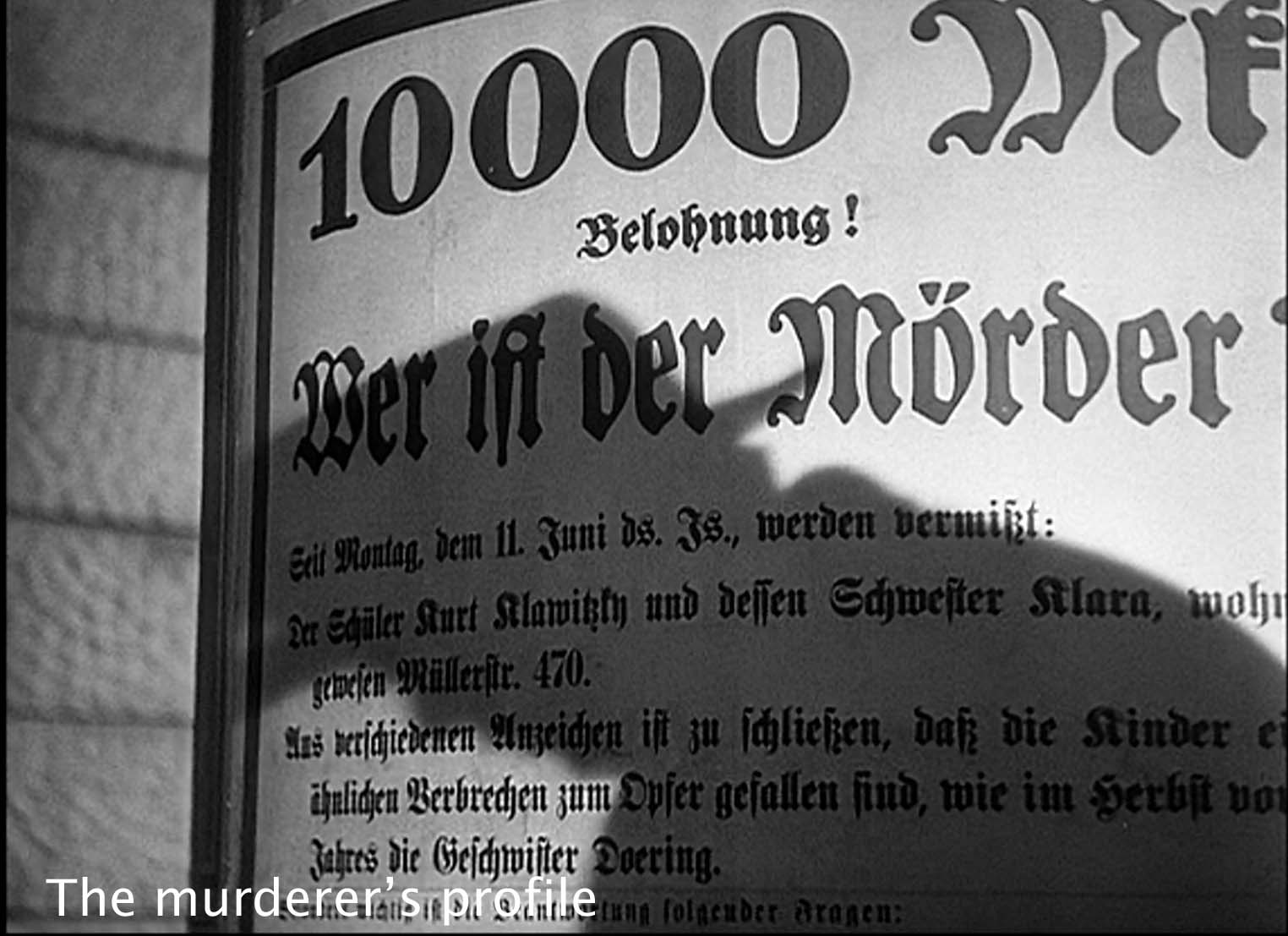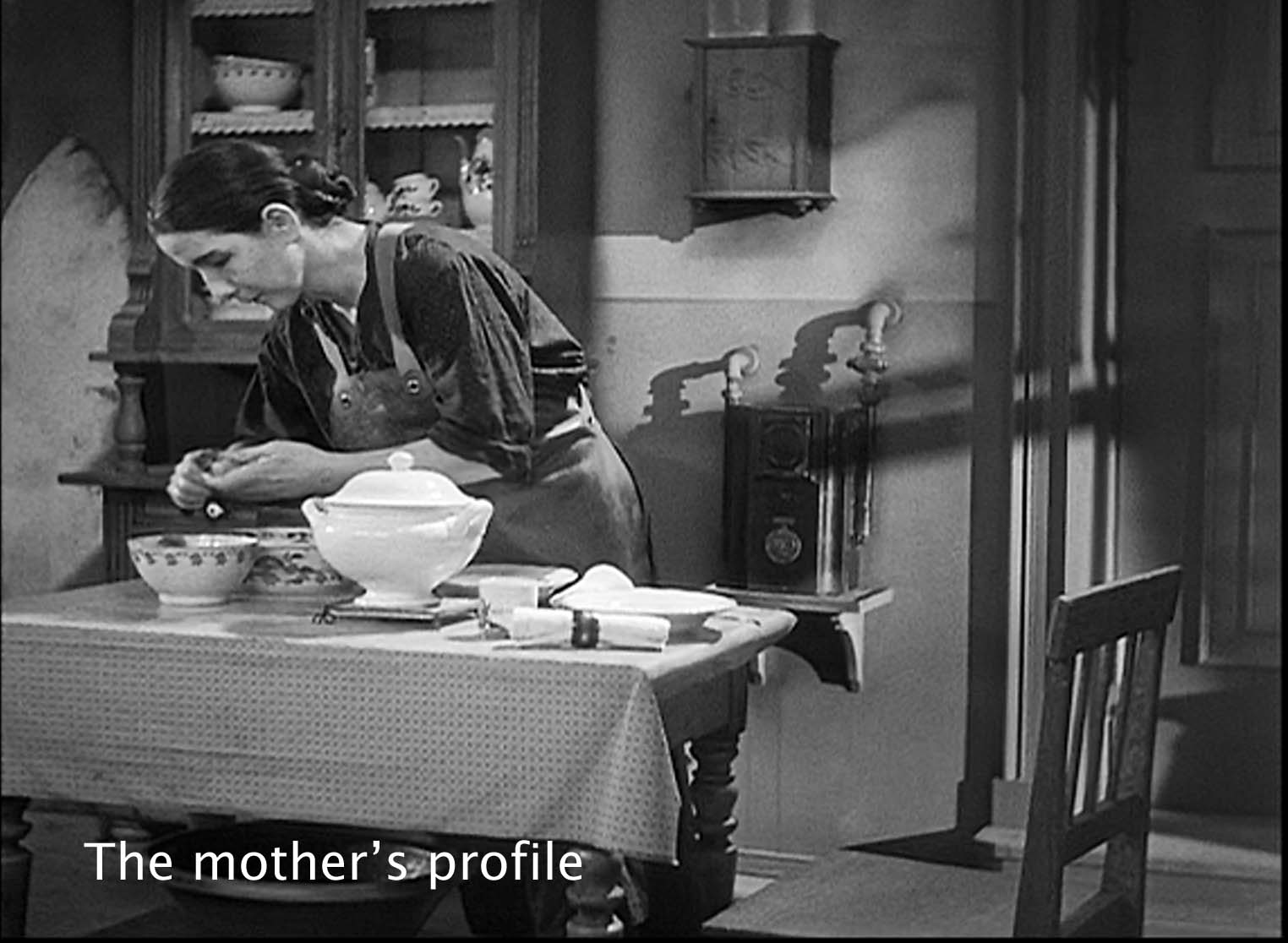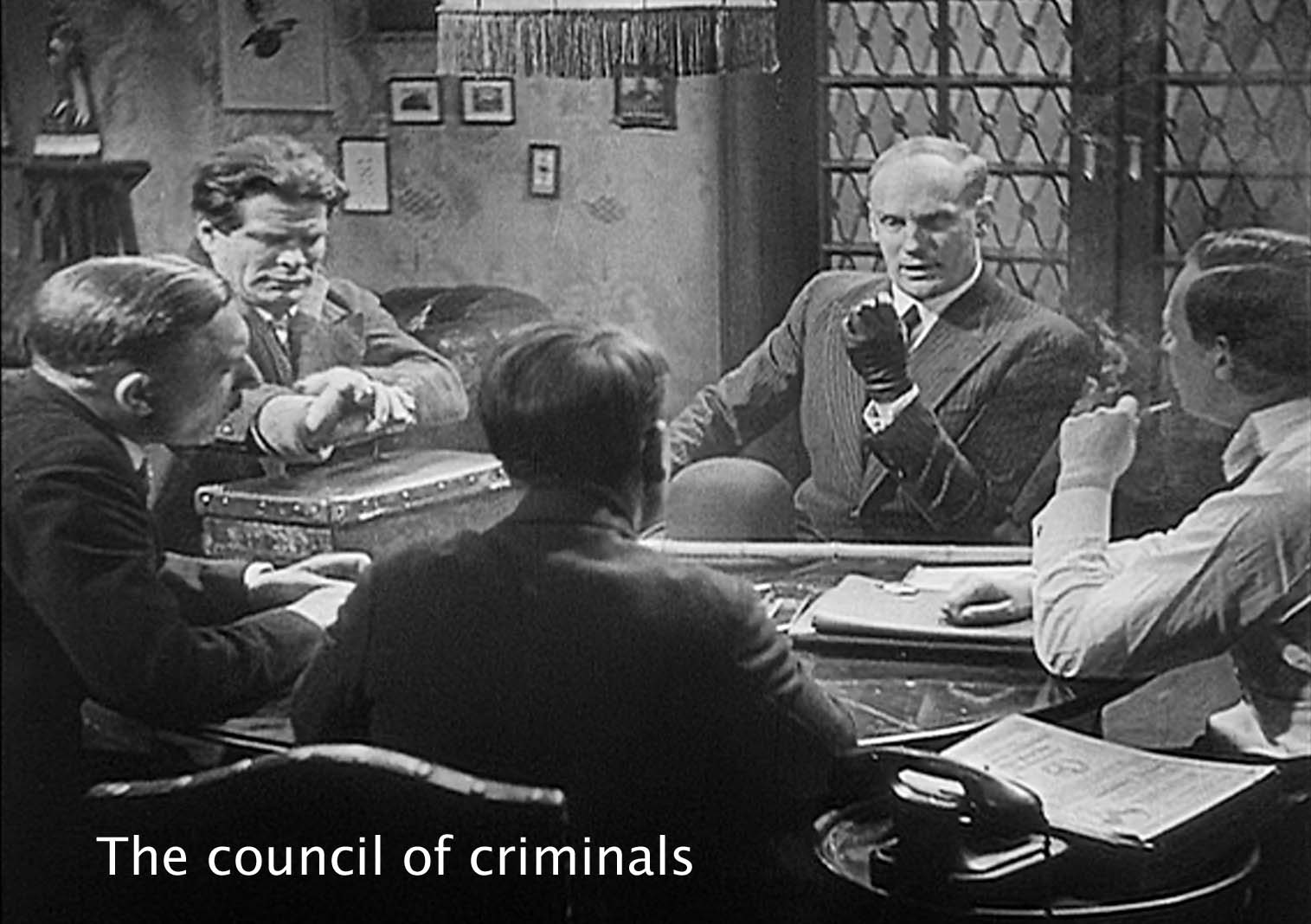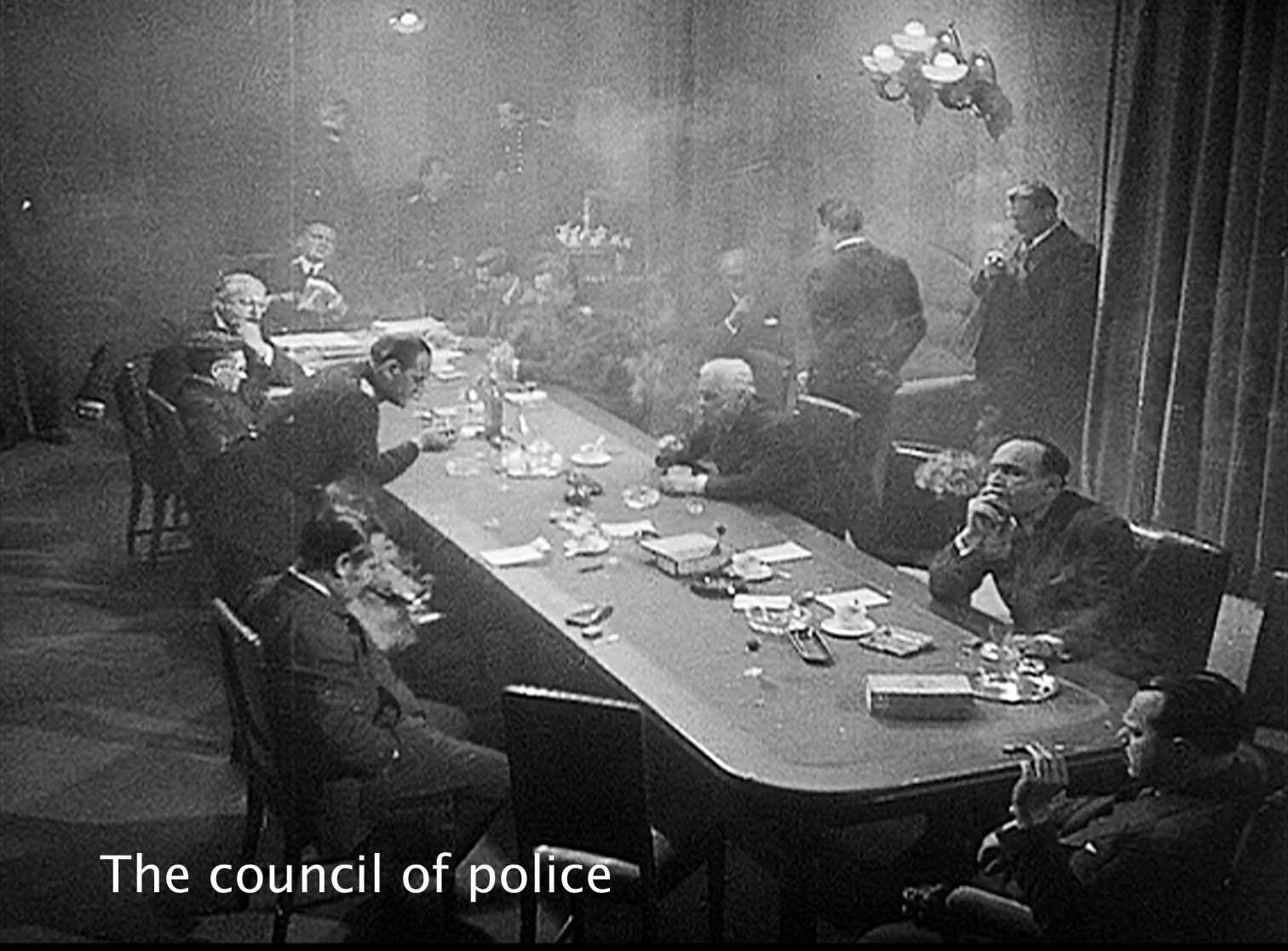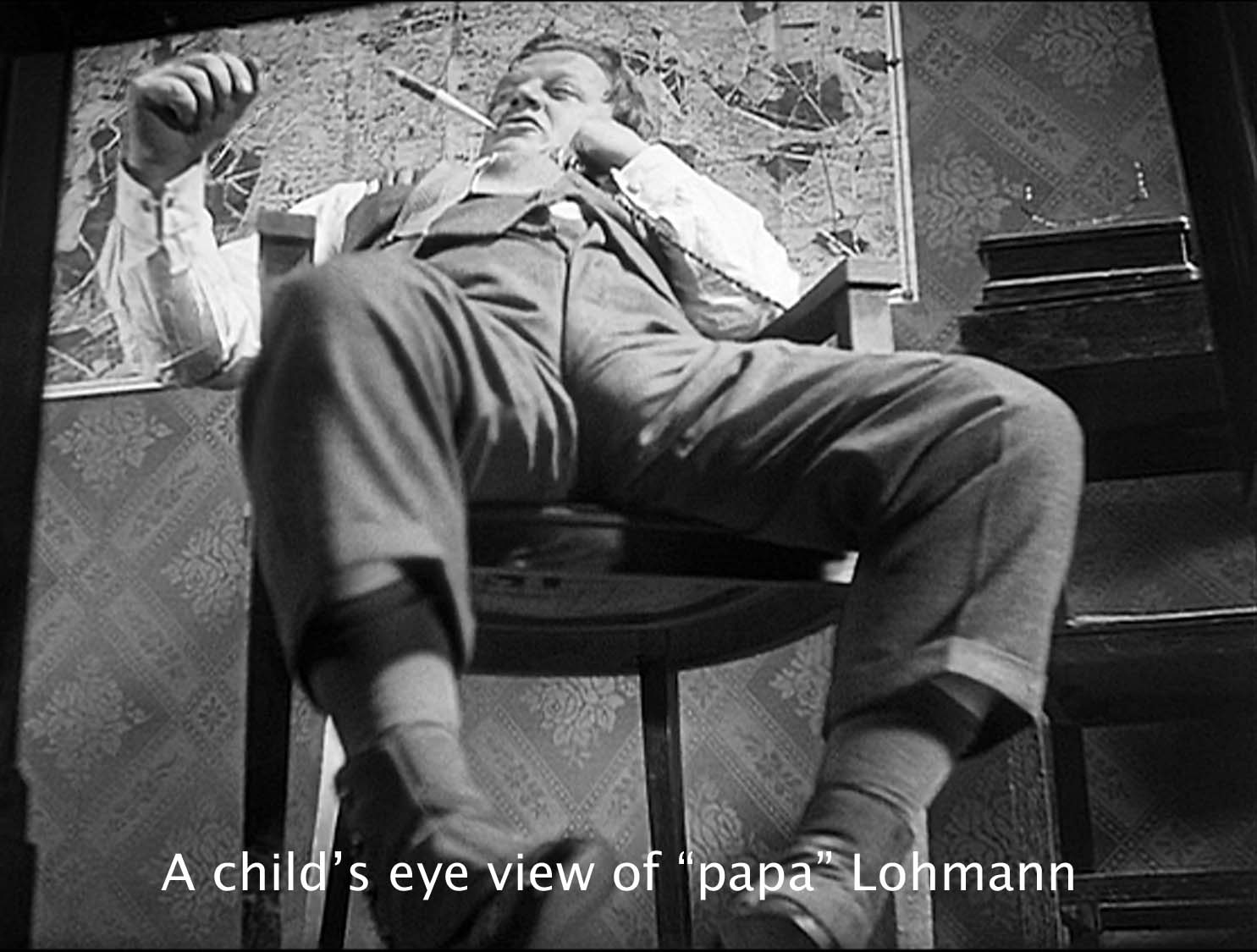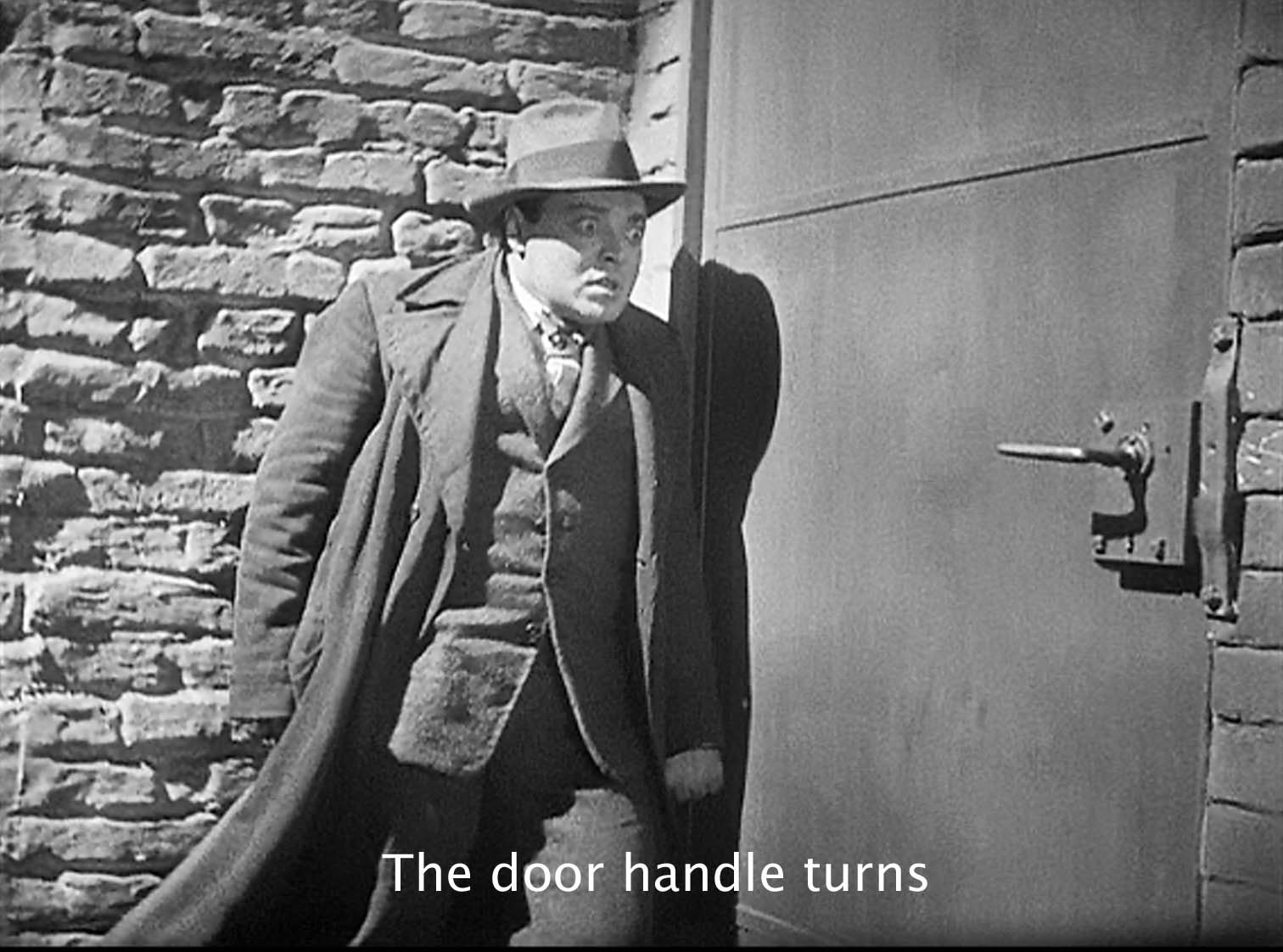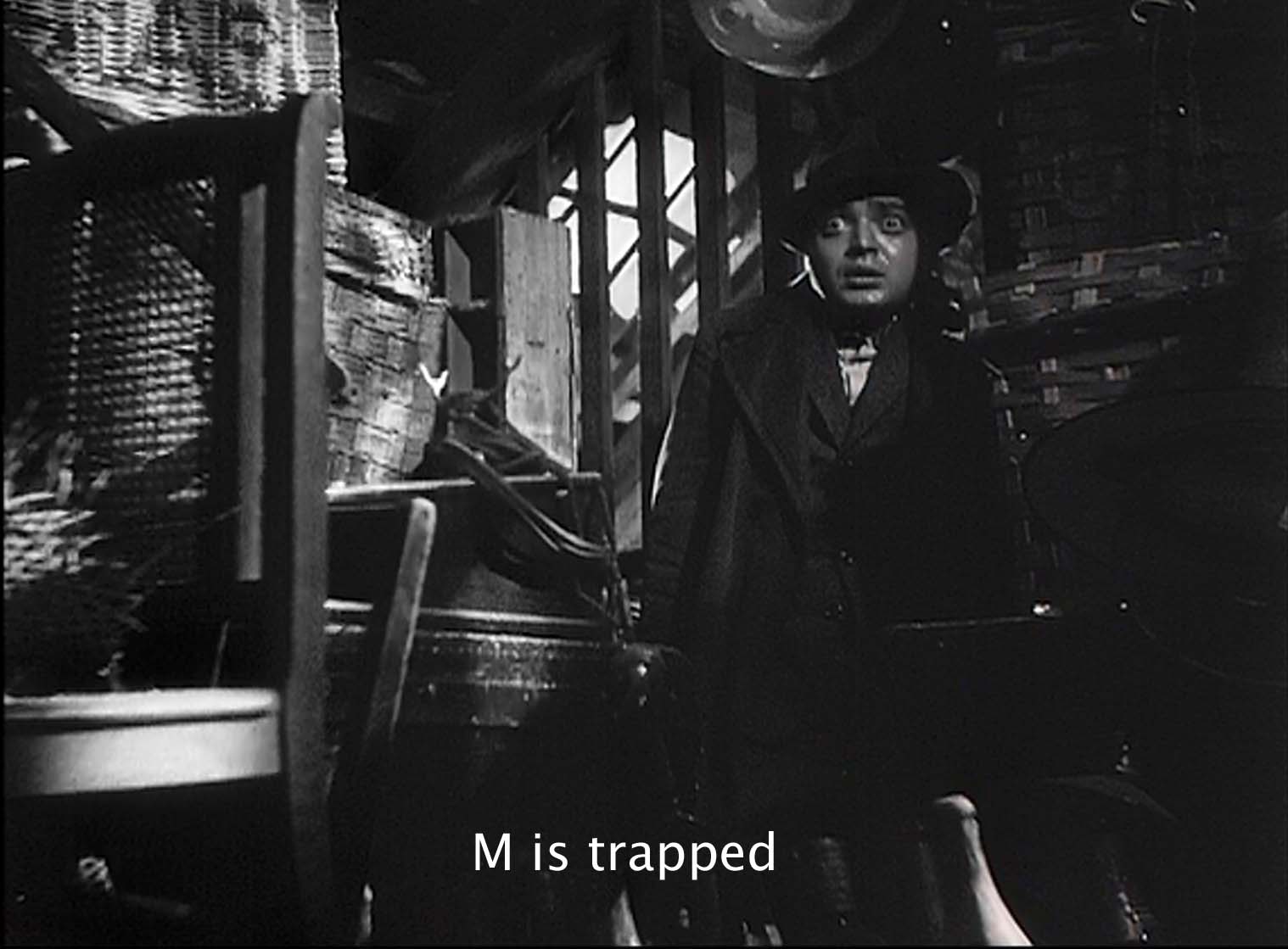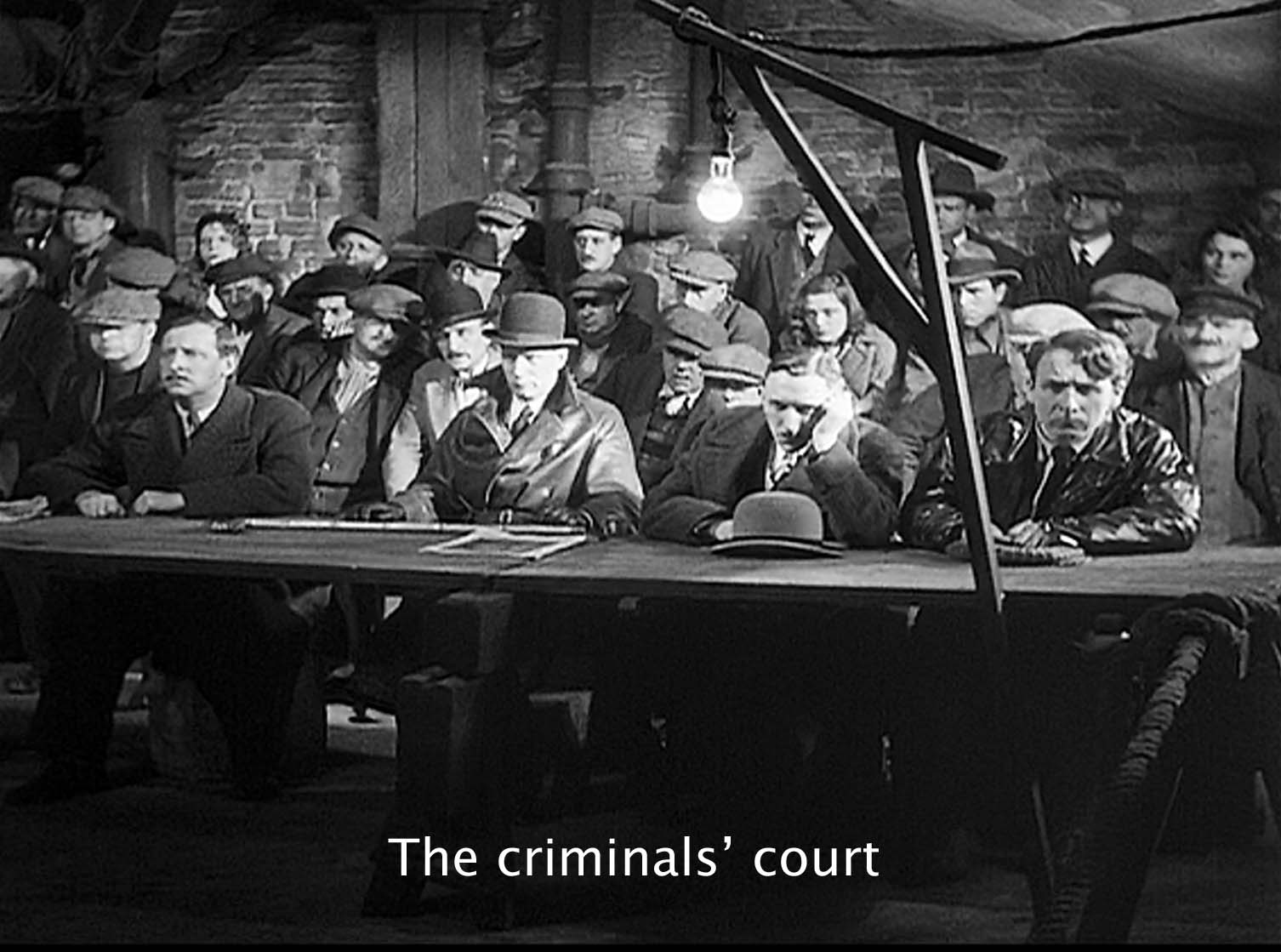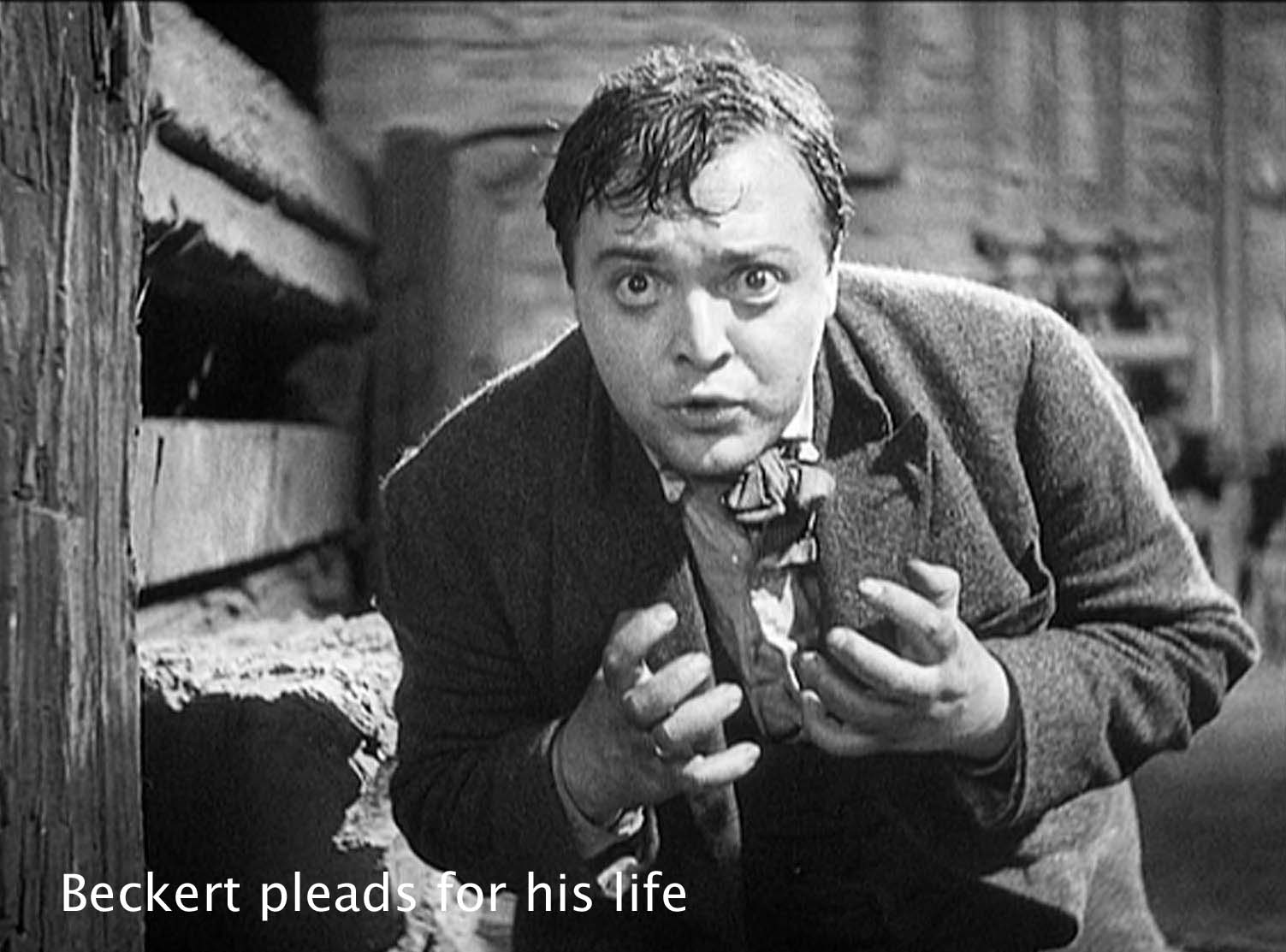Many people who write about M read it in terms of what was shortly to follow. M was released in 1931, and the mass hysteria and the elections that brought the Nazis to power took place in 1930 and 1932. But I think that kind of reading unduly narrows and trivializes the movie. Do we say of A Scarlet Letter that it is a picturesque study of life in an early New England village? Is Moby-Dick a fact-filled study of the whaling industry and War and Peace the true story of Napoleon’s defeat in Russia?
Rather, I think that this movie is a profound exploration of the nature of crime and punishment and justice. I think it develops a difference between run-of-the-mill crime like pickpocketing or safecracking and horrible crimes beyond human tolerance, like child murder. I think it develops the opposition between the psychological view of human beings and the legal and moral view. I think it hints at a profound difference between motherly and fatherly attitudes toward children. And I think it suggests that all of us, the “YOU!” with which the film ends, share the dark impulses that drive the murderer in this movie.
Aside from these weighty themes, Lang also created many innovations that would later become the film noir style. This is the first film that we could call a psychological thriller. Lang shoots from above. He puts us in a position where we are superior. We see all, we understand all, we comment on all. And he does amazing things with sound. Lang was so expert at telling a story with pictures in the manner of silent films that people predicted he would never make a sound picture. But this is his triumphant answer. He uses offscreen sounds to suggest a space beyond the film frame, a space we are to assume is filled with danger as when a car almost runs over a little girl near the beginning of the film. The gong that opens the film would have announced a newscast in 1931, news about the murder. Often we hear sound before we see the image from which it comes, creating a curious sense of fearful anticipation, as when we first hear the serial killer whistling. He has his murderer whistle “In the Hall of the Mountain King” by Grieg; this is the first time in movies that a musical leitmotiv has been linked to a character in the Wagnerian manner. Two characters order this film. The criminal, Hans Beckert or “M,” is played by Peter Lorre with unforgettable eyeballs. Karl Lohmann, played by Otto Wernicke is the chief inspector of police trying to catch Beckert. He is a great fat man who looks like Hermann Göring. This movie made stars of both these actors, hitherto relative unknowns.
Lohmann is always putting things in his mouth, cigars, coffee, or food. Beckert, too, is associated with candy and fruit. Both are what a psychoanalyst would call oral characters.
Food opens the movie with the murdered girl’s mother cooking, and I think that Lang uses food throughout to suggest how we all are driven by biological or psychological necessity.
At the same time, while the first segment of the film concentrates on the murdered girl’s mother, the second segment, the detection, belongs to Karl Lohmann, “Papa Lohmann,” who treats criminals like his children. In one astonishing shot, Lang looks at Lohmann from floor-level up to his crotch, his genitals bulging his trousers, a child’s-eye view of “papa.”
Throughout, of course, Beckert, M, looks and acts like a child, buying candy and toys, whistling, wandering aimlessly. Like Lohmann, he is always putting things in his mouth. There is a kind of family triangle here, the grieving mother, the harsh father, and the child who must be punished.
The first time we see Beckert’s face he is playacting. Acting, this image hints, is a kind of madness. Lang was fascinated by the idea of the artist being undone, particularly by some large organization like the police or a criminal gang. And here Beckert is a kind of artist who shapes this movie. And we are watching Beckert act, just as if we were watching a movie. That is one reason why the final odd plea in the movie, that we be more careful about children, is addressed to us. That is why the last word of the movie is “You!” We, watching people act out the horrors of this movie, demonstrate the darker side of human psychology. Consider one marvelous cut. When Lange first shows you Beckert’s shadow bending over Elsie, he cuts to her loving mother in the same posture, bending over lunch with a knife in her hand.
This amazing movie unfolds—or should I say unreels?— in four stages with a final coda: the crime; the detection of the criminal; the capture of the criminal; the trial of the criminal, and a last comment.
We first see a crime developing, the killing of little Elsie Beckmann by a serial child murderer. We see it primarily from the point of Elsie’s mother, Frau Beckmann (Ellen Widmann) who gradually realizes that her child is not coming home. It is an agonizing section of film, painful to watch, done with practically no dialogue in the manner of the silent films. Then, after the murder, we see the mass hysteria of the public who project guilt onto any man with or without any kind of evidence.
One dominant image in this first section is the circle. We open with a circle of children playing a murderous counting-out game. We see a ball and a balloon. We see the round post on which a public notice is posted. We see a cuckoo clock. Later, we see a circle of businessmen sitting at a round table in a stammtisch, a cafe, and again one of them is cast out. The girl in the counting-out game spins round like the hands of a clock.
Time is a major element throughout this film, particularly as Elsie’s mother agonizedly waits for her to come home. But time also rules in the second stage of the four: the detection. A cabinet minister insists the crime be solved right away. The crooks use a careful timetable in searching out the murderer. We even see a tableful of stolen watches.
There are two processes of detection: one by the police, one more effective, ironically, by the city’s crooks. The dominant image in this section is groups of people. This is a city film. We see humanity as a mass, especially a mass hysteria. We see ordinary life in the city in the form of policemen and files and maps and identity papers, media, telephones, radio, newspapers, telephones and policemen and people watching one another, watching, watching—all the means by which a modern society keeps the great mass of people that make it up in line.
This section is dominated not by circles but by groups and particularly by groups of men, accusing, planning, and acting. They represent, I think, those who manage, legally or illegally, the mass of people. One group is the police, and Lang gives us a carefully researched demonstration of the police techniques of the time: handwriting analysis, fingerprinting, crime scene investigation, and so on. But hurry, hurry says the cabinet minister. The other group is the criminals, a pleasantly bourgeois lot with a chummy relationship to the police (as in Brecht’s Threepenny Opera). They are losing business because of all the police activity, and they resolve to catch the murderer on their own.
And they are much better at it than the police. The divide the city into segments, and they have the league of beggars watch each segment. Rather quickly a blind beggar recognizes Beckert by his whistling. (Notice that the police detection is all by eye, the crooks’ detection all by ear.) Then, another beggar marks him with the “M” that is the movie’s title, M standing for Mörder, murderer, or perhaps Mensch, a human being. The beggars converge on Beckert and drive him into an office building that then closes for the night.
Circles dominated the first stage; groups of people the second. Now straight lines, squares and triangles dominate the third, the capture of the criminal. Earlier, a curious window display of an arrow and a spiral marked the transition from circles to straight lines.
In the third stage the film becomes an inverse heist movie. In a quasi-military operation, much more efficient than the cops’ earlier raid on a criminal hangout, the criminals knock out the watchmen and take over the office building, not to steal anything but to find Beckert. And they do. He is hidden among vertical lines in an attic. They take him away.
Again we have two processes, one outside the law (burgling the building), one within the law (but shady, not terribly ethical). Lohmann tricks the one burglar they caught into revealing what the criminals were up to. The criminals are going to give Beckert a trial. Again, we see a mass of people, but against them the solitary, agonized figure of Beckert. He makes an amazing plea for his life. (Peter Lorre acts this long monologue stunningly.) His “defense attorney” also makes a plea. But just as the crooks are about to lynch him, the police come in and take Beckert away to a more conventional trial.
This is the fifth stage, an astonishing coda to the film in which we return to the pathos of the crime in the opening stage. There will be a proper trial contrasted to the criminals’ kangaroo court. The judges file in, but we do not hear their verdict. Instead we cut to three mothers in the black veils of mourning. Elsie Beckmann’s mother says, “This will not bring the children back to life. We must be more careful about our children.” Then, “YOU!” and cut to black. In other words, whether the legal system kills Beckert or not, the pain and agony we witnessed in the first section of the film remains. For a grieving mother, the law’s retribution does absolutely nothing.
It is in the last two sections, the trial and the curious coda, that I think Lang builds his ideas on the more story-oriented first sections. Beckert pleads that he cannot help what he does. He is psychologically driven. Schränker, the safecracker-killer (Gustaf Gründgens), who is conducting the trial replies that that doesn’t matter. He is a monster who must be eliminated from society (incidentally safeguarding the crooks’ profits).
In effect, Lang is contrasting two conflicting views of man and crime, the psychological view and the legal and moral view. Psychologists and psychiatrists work in the deterministic world of science. Psychology says that humans are driven by stimuli and laws of behavior. Human behavior is determined. This is the view Beckert so pathetically urges. The law (in the person of one himself guilty of killings) says that that’s irrelevant. People are morally responsible, and they can only be morally responsible if they have choices. They are not determined. And whether or not they have choices, the justice system must get rid of this person who is disrupting society, that is, the profits from criminal activity and the cozy relationship between Papa Lohmann and his “children,” the everyday criminals.
Fritz Lang grew up in fin de siècle Vienna, often called the Golden Autumn of the Austro-Hungarian Empire that began in 1890 and ended with the Nazi Anschluss in 1938. It was the city of Gustave Mahler and Arnold Schönberg, of Gustav Klimt and Egon Schiele, and, of course, Freud. It was a culture preoccupied with dreams and fantasies and the idea of an unconscious mind and unconscious, irresistible impulses. And Fritz Lang carried that heritage of fantasy and dream into all his works from his silent films to his last works. In particular, his best silent films dealt with fantasy, Metropolis and Die Niebelungen. But by the time he created M, he was also practicing what Germans called, Die Neue Sachlichkeit or “The New Objectivity.” So this film is on the one hand grubby and gritty and realistic and on the other hand deeply involved with unconscious drives and fantasies.
Thus, he suggests, throughout the film, that ordinary people have the same unholy impulses that Beckert does. At the very moment when Elsie Beckmann is being killed, her mother is receiving the latest installment of a thriller magazine. In the opening scene, children imitate the killer in their counting-out game: “Just you wait, it won’t be long. The man in black will soon be here with his cleaver’s blade so true.” The people on the streets show a morbid interest in the details of the murders, set forth in posters and newspapers. They are eager to read about, and believe, horrors. Lang is hinting that the serial killer is just an exaggerated version of ordinary humanity. There is nothing new about The National Enquirer or The News of the World.
The coda says—this whole magnificent film says—we need to watch ourselves, we need to be careful about children, because we too harbor the murderous impulses that drove Hans Beckert. Otherwise, why are you watching this movie? Yes, “YOU!”
